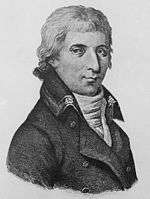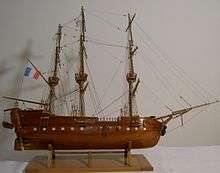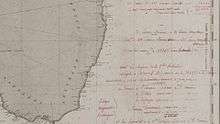Nicolas Baudin
| Nicolas Baudin | |
|---|---|
 | |
| Born |
17 February 1754 Saint-Martin-de-Ré, Île de Ré, France |
| Died |
16 September 1803 (aged 49) Mauritius |
| Nationality | French |
| Occupation | explorer, cartographer, naturalist, hydrographer |
Nicolas Thomas Baudin (17 February 1754 – 16 September 1803) was a French explorer, cartographer, naturalist and hydrographer.
Biography
Baudin was born a commoner in Saint-Martin-de-Ré on the Île de Ré. At the age of 15 he joined the merchant navy, and at 20 joined the French East India Company. He then joined the French navy and served in the Caribbean as an officer bleu during the American War of Independence.
In 1785 Baudin was captain of the Caroline taking Acadian settlers from Nantes to La Nouvelle Orléans.[1] In New Orleans he was contracted by local merchants to take a cargo of wood, salted meat, cod and flour to Isle de France (now Mauritius), which he did in the Josephine (also called Pepita), departing New Orleans on 14 July 1786 and arriving at Isle de France on 27 March 1787. In the course of the voyage, the Josephine had called at Cap Francais in Haiti to make a contract to transport slaves there from Madagascar; while there he also encountered the Austrian botanist Franz Josef Maerter, who apparently informed him that another Austrian botanist, Franz Boos, was at the Cape of Good Hope awaiting a ship to take him to Mauritius. The Josephine called at the Cape and took Boos on board.[2] At Mauritius, Boos chartered Baudin to transport him and the collection of plant specimens he had gathered there and at the Cape back to Europe, which Baudin did, the Josephine arriving at Trieste on 18 June 1788.[3] The Imperial government was contemplating organizing another natural history expedition, to which Boos would be appointed, in which two ships would be sent to the Malabar and Coromandel coasts of India, the Persian Gulf, Bengal, Ceylon, Sumatra, Java, Borneo, Cochin China, Tongking, Japan and China. Baudin had been given reason to hope that he would be given command of the ships of this expedition.[4]
Austrian expeditions
Baudin subsequently in 1788 sailed on a commercial voyage from Trieste to Canton in the Jardiniere. He apparently arrived at Canton from Mauritius under the flag of the United States of America, probably to avoid the possibility of having his ship seized by the Chinese for payment of the debts owed them by the Imperial Asiatic Company of Trieste.[5] From there, he sent the Jardiniere under her second captain on a fur trading venture to the North West Coast of America, but the ship foundered off Asuncion Island in the Mariannas in late 1789.[6]
Baudin made his way to Mauritius, where he purchased a replacement ship, the Jardiniere II, but this vessel was wrecked in a cyclone that struck Port Louis on 15 December 1789. Baudin embarked on the Spanish Royal Philippines Company ship, Placeres, which sailed from Port Louis for Cadiz in August 1790. The Placeres called at the Cape of Good Hope where the large number of plant and animal specimens collected in South Africa for the Imperial palace at Schönbrunn by Georg Scholl, the assistant of Franz Boos, was taken on board. Because of the poor condition of the ship, the voyage of the Placeres had to put in at the island of Trinidad, where Scholl's collection of specimens was deposited.[7]
Baudin proceeded to Martinique, from where he addressed an offer to the Imperial government in Vienna to conduct to Canton commissioners who would be empowered to negotiate with the Chinese merchants there a settlement of the debts incurred by the Imperial Asiatic Company, which would enable the company to renew its trade with China. On its return voyage from Canton, the proposed expedition would call at the Cape of Good Hope to pick up Scholl and the remainder of his natural history collection for conveyance to Schönbrunn.
After returning to Vienna in September 1791, Baudin continued to press his case for an expedition under the Imperial flag to the Indian Ocean and China, and in January 1792 he was granted a commission of captain in the Imperial navy for this purpose. A ship, called the Jardiniere, was acquired and the botanists, Franz Bredemeyer and Joseph van der Schot, appointed to the expedition. After delays caused by the outbreak of war between France and Austria, the Jardiniere departed from the Spanish port of Málaga on 1 October 1792.[8] From the Cape of Good Hope the Jardiniere sailed across the Indian Ocean to the coast of New Holland (Australia) but two consecutive cyclones prevented the expedition from doing any work there and forced Baudin to take the ship to Bombay for repairs.
From Bombay, the expedition proceeded to the Persian Gulf, Red Sea and East Coast of Africa, where botanical and zoological collections were gathered. The expedition came to an abrupt end in June 1794 when the Jardiniere went aground in a storm while attempting to enter Table Bay at the Cape of Good Hope. Baudin survived the wreck and made his way to the United States, from where he went to France.[9] He managed to send the Jardiniere's cargo of natural history specimens to the island of Trinidad.
Belle Angélique Expedition
In Paris, Baudin visited Antoine de Jussieu at the Museum National d'Histoire Naturelle in March 1796 to suggest a botanical voyage to the Caribbean, during which he would recover the collection of specimens he had left in Trinidad. The proposal was accepted by the Museum and French government, and Baudin was appointed commander of an expedition in the ship, the Belle Angélique, with four assigned botanists, René Maugé, André Pierre Ledru, Anselme Riedlé and Stanislas Levillain. The Belle Angélique cleared Le Havre on 30 September 1796 for the Canary Islands, where the ship was condemned as unseaworthy. The expedition sailed from the Canaries in a replacement vessel, the Fanny, and reached Trinidad in April 1797. The island had just been captured from the Spanish by the British, who refused to allow Baudin to recover his collection of natural history specimens. Baudin took the Fanny to St. Thomas and St. Croix, and then to Puerto Rico, specimens being collected in all three islands. At St Croix, the Fanny was replaced by a newly purchased ship, which was renamed the Belle Angelique.[10] The expedition returned to France in June 1798 with a large collection of plants, birds and insects, which was incorporated into Napoleon Bonaparte's triumphal procession celebrating his recent Italian victories.[11]

On 24 July 1798, at the suggestion of the Ministry of Marine, Baudin presented to the Assembly of Professors and Administrators of the National Museum of Natural History a plan for a hydrographic survey expedition to the South Seas, which would include a search for fauna and flora that could be brought back for cultivation in France. The expedition would also have the aim of promoting the economic and commercial interests of France in the regions to be visited. The expedition would require two well-equipped ships, which would carry a team of astronomers, naturalists and scientific draughtsmen over whom Baudin as commander would have absolute authority. The first part of the voyage would be devoted to a thorough exploration of the coast of Chile and the collection of animal, bird and plant specimens suitable for acclimatization in France, followed by a survey of the coasts from Peru to Mexico. The expedition would then continue into the Pacific Ocean, including a visit to Tahiti and the Society Islands, and would be completed with a survey of the yet unexplored south west coast of New Holland (Australia).[12] After considering this extensive proposal, the French government decided to proceed with an expedition confined to a survey of western and southern New Holland (as Australia was called at the time).
New Holland Expedition

In October 1800 he was selected to lead what has become known as the Baudin expedition to map the coast of Australia (New Holland). He had two ships, Géographe and Naturaliste captained by Hamelin, and was accompanied by nine zoologists and botanists, including Jean Baptiste Leschenault de la Tour. He reached Australia in May 1801, and would explore and map the western coast, and a part of the little known southern coast of the continent. The scientific expedition was a great success, with more than 2500 new species discovered. The French also met Aboriginal Peoples and treated them with high respect.
In April 1802, he met Matthew Flinders, also engaged in charting the coastline, in Encounter Bay. Baudin then stopped at the British colony at Sydney for supplies. In Sydney he bought a new ship — Casuarina — named after the wood it was made from. From there he sent home Naturaliste, which had on board all of the specimens that had been discovered by Baudin and his crew. He then headed for Tasmania, before continuing north to Timor. Baudin then sailed for home, stopping at Mauritius, where he died of tuberculosis.
According to researchers from the University of Adelaide, during this expedition Baudin prepared a report for Napoleon on ways to invade and capture the British colony at Sydney Cove.[13]
Death
Baudin died at Mauritius in 1803 at the age of 49, of tuberculosis, apparently in the home of Madame Alexandrine Kerivel. Baudin's exact resting place is not known, but the historian Auguste Toussaint believed that he was interred in the Kerivel family vault. However, the historian Edward Duyker likes to think that Baudin was buried in Le Cimetière de l’Ouest in the district of Port Louis "just a few hundred meters from the explorer’s certain love: the sea".[14]
Legacy

In South Australia, the following places bear Baudin's name - Baudin Beach on Kangaroo Island, Baudin Rocks on the south-east coast of the state and Nicolas Baudin Island on the west coast of Eyre Peninsula. A number of monuments have been established around Australia, including eight at various locations around Western Australia.[15]
One Mexican frog and two Australasian lizards are named in honour of Baudin:
- Smilisca baudini (Duméril & Bibron, 1841) – Common Mexican tree frog (Hylidae)
- Emoia baudini (Duméril & Bibron, 1839) – Baudin's Emo Skink (Scincidae)
- Pseudemoia baudini (Duméril, Smith & Johnstone, 1981) – Bight Coast Skink (Scincidae)
See also
- Baudin expedition to Australia
- European and American voyages of scientific exploration
- Freycinet Map of 1811
- Baudin pig
References
- ↑ Carl A. Brasseaux, The Founding of New Acadia: The Beginnings of Acadian Life in Louisiana, 1765-1803, Baton Rouge, Louisiana State University Press, 1987, p109; William Dawson Gerrior, Acadian Awakenings: Louisiana, Port Royal Pub., 2003, pp.73, 104; Madeleine Ly-Tio-Fane, Le Géographe et le Naturaliste à l'île-de-France: ultime escale du capitaine Baudin, Port-Louis, Ile Maurice, 2003, p.33.
- ↑ David K. Wetherbee, Further Contributions to the History of Zoology in Hispaniola, Shelburne, Massachusetts, 1987.
- ↑ Sébastien Brunner (ed.), Correspondances intimes de l'Empereur Joseph II avec son ami le comte de Cobenzl et son premier ministre le prince de Kaunitz, Mainz, Kirchheim, 1871, p.75.
- ↑ Madeleine Ly-Tio-Fane, Le Géographe et le Naturaliste à l'île-de-France 1801, 1803 : ultime escale du capitaine Baudin, Port-Louis, Ile Maurice, 2003, pp.50-51; Sébastien Brunner (ed.), Correspondances intimes de l'Empereur Joseph II avec son Ami le Comte de Cobenzl et son Premier Ministre le Prince de Kaunitz, Mainz, Kirchheim, 1871, p.75.
- ↑ Hosea Ballou Morse, The Chronicles of the East India Company Trading to China, 1635-1834, Oxford, Clarendon Press, 1926, Vol.II, p.174.
- ↑ Madeleine Ly-Tio-Fane, “Contacts between Schönbrunn and the Jardin du Roi at Isle de France (Mauritius) in the 18th Century”, Mitteilungen des Oesterreichischen Staatsarchiv, No.35, 1982, pp.85-109, p.102; Frank Horner, The French reconnaissance: Baudin in Australia, 1801-1803, Melbourne University Press, 1987, p.26.
- ↑ Gazeta de Madrid, 19 de Julio de 1791, p.501.
- ↑ Madeleine Ly-Tio-Fane, “Contacts between Schönbrunn and the Jardin du Roi at Isle de France (Mauritius) in the 18th Century”, Mitteilungen des Oesterreichischen Staatsarchiv, No.35, 1982, pp.85-109.
- ↑ Madeleine Ly-Tio-Fane, “Contacts between Schönbrunn and the Jardin du Roi at Isle de France (Mauritius) in the 18th Century”, Mitteilungen des Oesterreichischen Staatsarchiv, No.35, 1982, pp.85-109, p.102; Frank Horner, The French reconnaissance: Baudin in Australia, 1801-1803, Melbourne University Press, 1987, p.28.
- ↑ Madeleine Ly-Tio-Fane, "A reconnaissance of tropical resources during Revolutionary years: the role of the Paris Museum d'Histoire Naturelle", Archives of Natural History, vol.18, 1991, pp.352–355.
- ↑ André Pierre Ledru, Voyage aux iles de Teneriffe, la Trinite, Saint-Thomas Sainte-Croix et Porto Ricco, Paris, Bertrand, 1810; Nicolas Baudin, Voyage aux Antilles de La Belle Angélique, édition établie et commentée par Michel Jangoux, préface du contre-amiral Georges Prud'homme, Paris, PUPS, coll. « Imago mundi-Textes », 2009.
- ↑ Baudin aux Citoyens Professeurs et Adminitstrateurs du Museum nationale d’histoire naturelle à Paris, 6 Thermidor An VI [24 Juillet 1798], Archives nationales, Paris, AJXV 569, ff.178-179; cited in Madeleine Ly-Tio-Fane, "A reconnaissance of tropical resources during Revolutionary years: the role of the Paris Museum d'Histoire Naturelle", Archives of Natural History, vol.18, 1991, pp.333–362, p.358.
- ↑ "Sacre bleu! French invasion plan for Sydney". ABC News. 10 December 2012.
- ↑ Duyker, E. (1999) In Search of Madame Kerivel and Baudin’s Last Resting Place. National Library of Australia News, vol. IX, no. 12, September, pp. 8–10.
- ↑ "Terra Australis 2001, Western Australian Association Inc., Monuments Program Synopsis". Multicultural communities online. Retrieved 21 August 2015.
Further reading
- Nicolas Baudin, Voyage aux Antilles de La Belle Angélique, édition établie et commentée par Michel Jangoux, préface du contre-amiral Georges Prud'homme, Paris, PUPS, coll. « Imago mundi-Textes », 2009.
- Beck, Hanno. ”Das Ziel der grossen Reise Alexander von Humboldts” (The Aim of Alexander von Humboldt's Great Expedition), Erdkunde, Bd. 12, H. 1 (Feb., 1958), pp. 42–50.
- BERENGER, Jean. ‘Joseph II et les Sciences naturelles’, in Portés par l'air du temps: les voyages du Capitaine Baudin: Etudes sur le 18e siècle, vol.38, Bruxelles, Editions de l'Université de Bruxelles, 2010.
- Bonnemains, J., Forsyth, E. and Smith, B. Baudin in Australian Waters: The Artwork of the French Voyage of Discovery to the Southern Lands 1800—1804 With a Descriptive Catalogue of Drawings and Paintings of Australian Subjects by C. –A. Lesueur and N.-M. Petit from the Lesueur Collection at the Muséum d’Histoire Naturelle, Le Havre, France Oxford University Press, Melbourne, 1988.
- Bonnemains, J., Argentin, J.-M. and Marin, M. (eds) Mon voyage aux Terres Australes: Journal personnel du commandant Baudin, Éditions Imprimerie Nationale, Paris, 2000.
- Bouvier, R. & Maynial, E. Une Aventure dans les Mers Australes: L’Expédition du Commandant Baudin (1800—1803), Mercure de France, Paris, 1947.
- Brown, A. J. Ill-starred Captains: Flinders and Baudin, Crawford House, Adelaide, 2000.
- Cornel, C. (trans.) The Journal of Post Captain Nicolas Baudin, Adelaide, 1974.
- Duyker, E. In Search of Madame Kerivel and Baudin’s Last Resting Place, National Library of Australia News, vol. IX, no. 12, September 1999, pp. 8–10.
- Duyker, E. François Péron: An Impetuous Life: Naturalist and Voyager, Miegunyah/Melbourne University Press, Melbourne, 2006, ISBN 978-0-522-85260-8.
- Jean Fornasiero, Peter Monteath and John West-Sooby, Encountering Terra Australis: the Australian voyages of Nicholas Baudin and Matthew Flinders, Kent Town, South Australia, Wakefield Press, 2004. ISBN 1-86254-625-8.
- Jean Fornasiero and John West-Sooby, “Naming and shaming: the Baudin expedition and the politics of nomenclature in the Terres Australes”, in Anne M. Scott, Alfred Hiatt, Claire McIlroy and Christopher Wortham (eds.), European Perceptions of Terra Australis, Farnham, Ashgate, 2012, pp. 165–184.
- Horner, F. The French Reconnaissance: Baudin in Australia 1801—1803, Melbourne University Press, Melbourne, 1987 ISBN 0-522-84339-5.
- Jangoux, Michel. Portés par l'air du temps: les voyages du Capitaine Baudin, Bruxelles, Editions de l'Université de Bruxelles, 2010.
- Jangoux, Michel. 'Le voyage de la Belle Angélique : l’expédition aux Antilles de Nicolas Baudin (1796-1798)’ in Portés par l'air du temps: les voyages du Capitaine Baudin: Etudes sur le 18e siècle, vol.38, Bruxelles, Editions de l'Université de Bruxelles, 2010.
- R. Kingston, A not so Pacific voyage: the ‘floating laboratory’ of Nicolas Baudin], Endeavour, vol. XXXI, no. 4, December 2007, pp. 145–151.
- Ly-Tio-Fane, Madeleine. "A reconnaissance of tropical resources during Revolutionary years: the role of the Paris Museum d'Histoire Naturelle", Archives of Natural History, vol.18, 1991, pp. 333–362.
- Ly-Tio-Fane, Madeleine (1996). "Botanic gardens: connecting links in plant transfer between the Indo-Pacific and Caribbean regions", Harvard Papers in Botany, 8: 7–14.
- Ly-Tio-Fane, Madeleine, Le Géographe et Le Naturaliste à L’Ile-de-France 1801, 1803, Ultime Escale du Captaine Baudin: Deuxième Partie, Le Voyage de Découvertes aux Terres australes, Collection Lesueur du Muséum d’histoire naturelle du Havre, Dossier 15: Catalogue établi Jacqueline Bonnemains commenté par Madeleine Ly-Tio-fane, MSM Limited, Port Louis [Mauritius], 2003.
- Reynolds, Steve. Nicolas Baudin's Scientific Expedition To The Terres Australes, Marine Life Society of South Australia Inc.
- Plomley, B. The Baudin Expedition and the Tasmanian Aborigines 1802, Blubber Head Press, Hobart, 1983
- Rivas, Michèle. « Un navigateur-naturaliste d'origine poitevine célèbre en Australie, méconnu dans sa patrie: Nicolas Baudin (1754-1803)», Revue Historique du Centre-Ouest (Poitiers), tome V, 1er semestre 2006 pp. 73–112.
- RIVAS,Michèle. ‘Nicolas Baudin, M de Beaumarchais et la guerre d’indépendance des Etats-Unis d’Amérique’, in Portés par l'air du temps: les voyages du Capitaine Baudin: Etudes sur le 18e siècle, vol.38, Bruxelles, Editions de l'Université de Bruxelles, 2010.
- Toft, Klaus. The Navigators - Flinders vs Baudin, Sydney, Duffy and Snellgrove, 2002. ISBN 1-876631-60-0